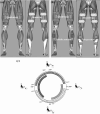Effects of releasing ankle joint during electrically evoked cycling in persons with motor complete spinal cord injury
- PMID: 38499594
- PMCID: PMC10948841
- DOI: 10.1038/s41598-024-56955-w
Effects of releasing ankle joint during electrically evoked cycling in persons with motor complete spinal cord injury
Abstract
Literature has shown that simulated power production during conventional functional electrical stimulation (FES) cycling was improved by 14% by releasing the ankle joint from a fixed ankle setup and with the stimulation of the tibialis anterior and triceps surae. This study aims to investigate the effect of releasing the ankle joint on the pedal power production during FES cycling in persons with spinal cord injury (SCI). Seven persons with motor complete SCI participated in this study. All participants performed 1 min of fixed-ankle and 1 min of free-ankle FES cycling with two stimulation modes. In mode 1 participants performed FES-evoked cycling with the stimulation of quadriceps and hamstring muscles only (QH stimulation), while Mode 2 had stimulation of quadriceps, hamstring, tibialis anterior, and triceps surae muscles (QHT stimulation). The order of each trial was randomized in each participant. Free-ankle FES cycling offered greater ankle plantar- and dorsiflexion movement at specific slices of 20° crank angle intervals compared to fixed-ankle. There were significant differences in the mean and peak normalized pedal power outputs (POs) [F(1,500) = 14.03, p < 0.01 and F(1,500) = 7.111, p = 0.008, respectively] between fixed- and free-ankle QH stimulation, and fixed- and free-ankle QHT stimulation. Fixed-ankle QHT stimulation elevated the peak normalized pedal PO by 14.5% more than free-ankle QH stimulation. Releasing the ankle joint while providing no stimulation to the triceps surae and tibialis anterior reduces power output. The findings of this study suggest that QHT stimulation is necessary during free-ankle FES cycling to maintain power production as fixed-ankle.
Keywords: Ankle biomechanics; Functional electrical stimulation; Paraplegics; Pedal power; Rehabilitation.
© 2024. The Author(s).
Conflict of interest statement
The authors declare no competing interests.
Figures





Similar articles
-
Stimulation of shank muscles during functional electrical stimulation cycling increases ankle excursion in individuals with spinal cord injury.Arch Phys Med Rehabil. 2012 Nov;93(11):1930-6. doi: 10.1016/j.apmr.2012.05.012. Epub 2012 May 24. Arch Phys Med Rehabil. 2012. PMID: 22634232 Clinical Trial.
-
Consequences of ankle joint fixation on FES cycling power output: a simulation study.Med Sci Sports Exerc. 2005 May;37(5):797-806. doi: 10.1249/01.mss.0000161802.52243.95. Med Sci Sports Exerc. 2005. PMID: 15870634
-
Mechanomyography responses characterize altered muscle function during electrical stimulation-evoked cycling in individuals with spinal cord injury.Clin Biomech (Bristol). 2018 Oct;58:21-27. doi: 10.1016/j.clinbiomech.2018.06.020. Epub 2018 Jul 2. Clin Biomech (Bristol). 2018. PMID: 30005423
-
Oxygen consumption during functional electrical stimulation-assisted exercise in persons with spinal cord injury: implications for fitness and health.Sports Med. 2008;38(10):825-38. doi: 10.2165/00007256-200838100-00003. Sports Med. 2008. PMID: 18803435 Review.
-
FES cycling.Acta Neurochir Suppl. 2007;97(Pt 1):395-402. doi: 10.1007/978-3-211-33079-1_52. Acta Neurochir Suppl. 2007. PMID: 17691402 Review.
References
MeSH terms
Grants and funding
LinkOut - more resources
Full Text Sources
Medical
Miscellaneous

